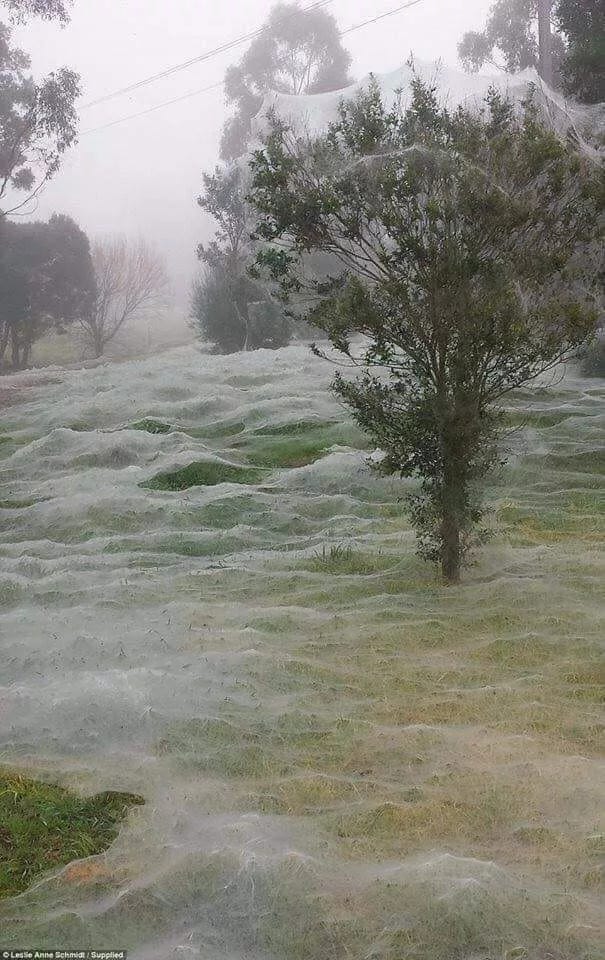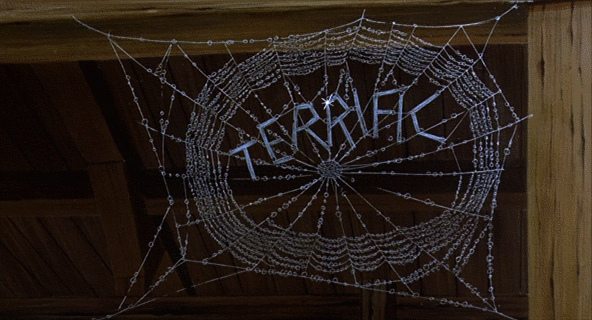
In July 2016, Pokémon Go sent players scattering all over the world – often in places they wouldn’t otherwise go. The augmented reality game led to discoveries that were all too real; hapless players chased Pokémon into graveyards and strip clubs, strangers’ yards and public toilets. One player even discovered a body.
In Australia, two Pokémon Go players were absorbed in their phones when they wandered into a park. When they looked up, they blinked, because the world suddenly looked even more fantastic than the fictional creatures they’d been chasing.
Bushes, trees, endless expanses of grass were all netted what looked like a fine mist. Up close, it was clear that they were looking at spiderwebs. It was as if a giant blanket had descended from the sky and dropped neatly on top of the landscape, covering everything in sight. With phones in hand anyway, they snapped some photos that quickly spread across the internet.
It turns out, this story is 100% true.

This same phenomenon also occurred in New South Wales (also Australia) in 2015. Farmers woke up to find their fields absolutely covered in webs. Taking in the disorienting scene, some hopeful believers wondered if aliens were to blame. But scientists say it’s actually quite normal, if odd.
When spiders want to migrate, they can’t fly or walk – they’re too small, and they don’t have wings, and it takes too long to scrabble over obstacles like grass and bushes. If there’s a fire or flood, they’re especially imperiled.
So over time, they’ve evolved. Whether they’re fleeing a natural disaster or just on the move, spiders have learned to cast their silk to ride the air currents. They can drift for miles, even across oceans, and land just as suddenly. It’s happened in Pakistan and Tennessee, and it’s why we have spiders on every continent, even on Antarctica where most can’t actually survive. Scientists call it “ballooning,” as if the spiders are explorers setting off to see the world by sky.

Illustration by Alexandra Dvornikova
While ballooning is an evolutionary miracle, fake spiderwebs – those Halloween decorations made from sticky cotton – are their own natural disaster at this time of year. eHow has a characteristically absurd guide to putting them up; you simply stretch them out and pin or tape or hang them where you want them to go.
Though fake spiderwebs are a cheap and effective Halloween decoration, they’re terrible for birds and other creatures. Halloween coincides with birds’ migration season, and the webs can catch them in midair, seizing tighter every time a trapped bird flinches and struggles.
"I just had a golden-crowned kinglet come in yesterday that weighed in at a whole 5.9 grams," Chantal Theijn, a Canadian wildlife rehabilitator, told a reporter last year. "So you can imagine how tiny these birds are; everything is an obstacle for them. At 5.9 grams, they don't have the strength to get themselves loose."
Still, the sticky cotton fake spider webs aren’t the only ones. Fake spiderwebs occur in nature, too.
http://mentalfloss.com/article/59670/some-plants-might-protect-themselves-fake-spiderwebs
While doing field work on plant defenses in Japan, biologist Kazuo Yamazaki kept finding plants that appeared to be covered in spiderwebs. Halfway around the world, botanist Simcha Lev-Yadun found the same thing while doing research in Israel, Greece, and Estonia.
On its own, that isn’t out of the ordinary. While you or I might not like a spider calling our bodies home, it’s a great arrangement for plants because spiders eat various plant-eating insects. It’s like having a round-the-clock, live-in (or live-on) bodyguard. Spiders are such effective protectors that some plants lure and reward them for their service with extrafloral nectar (which isn’t in the flowers and isn’t used to attract pollinators).
When Yamazaki and Lev-Yadun inspected the plants more closely, though, they found that they weren’t looking at spiderwebs after all. What they’d been seeing were patches of trichomes, hair-like growths on the plants’ outer layers. The plants had fooled them,and maybe, they thought, that was the point. If a plant can’t attract a spider bodyguard, the next best thing might be to fake it. By mimicking the signs that a spider is nearby, a web being an obvious signal, the plants could scare off insect pests without having to invest in rewards or attractants for actual spiders.

Something else
I’ll end this newsletter with a confession: I’m TERRIFIED of spiders. Cannot be near them or look at pictures of them without full-body shuddering. But I know they’re good for the planet, and my Christmas cactus always has a fruit fly or two buzzing around it, so I recently decided to let a little spider set up camp underneath our TV.
I haven’t seen the spider in weeks, but I do think he’s helping mitigate the flying bug issue. On a semi-recent episode of Baby Geniuses (my favorite podcast), Emily Heller recommended this soft grabber for relocating creepy crawlies, and I think I’m going to buy one, too. (Apologies for the Amazon link! I’m sure you can find one at your local hardware store.)
Illustrations by Anna Doherty


